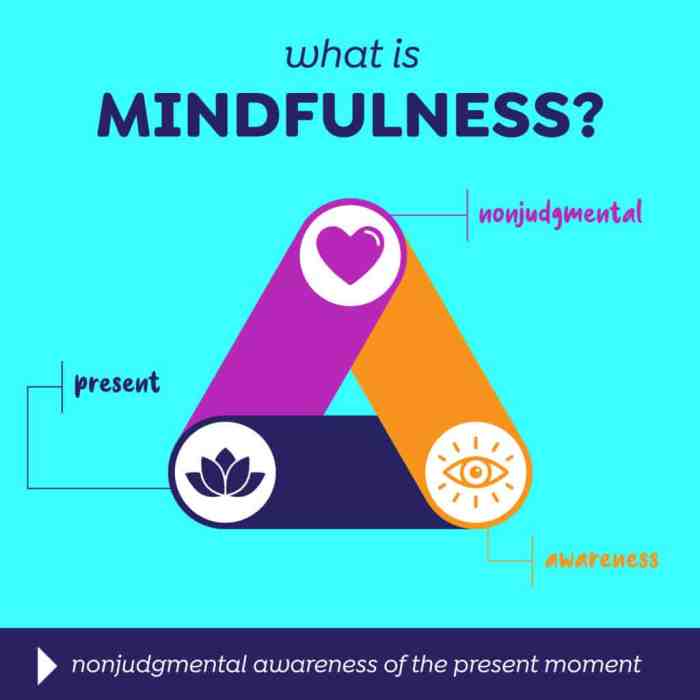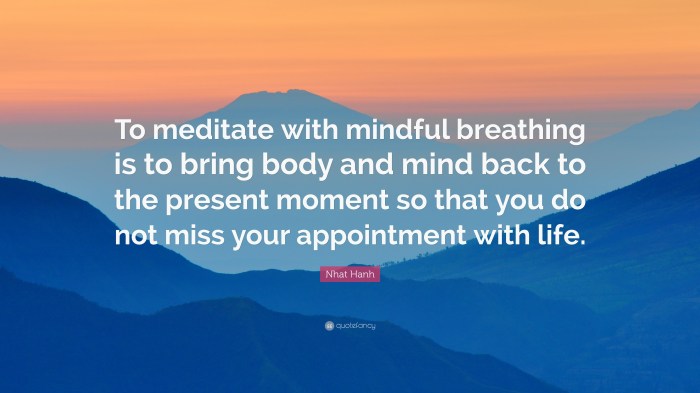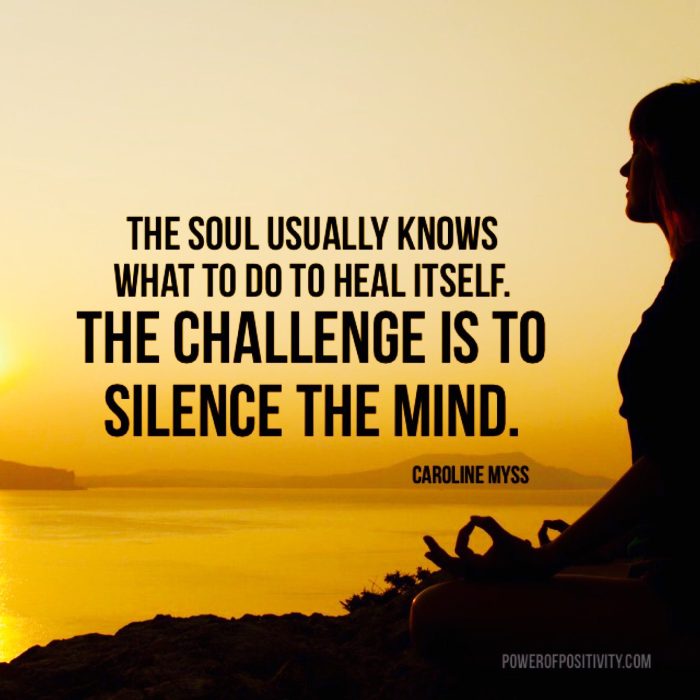Delving into How to Meditate for Enhancing Your Awareness of the Present Moment, this introduction immerses readers in a unique and compelling narrative, with engaging and thought-provoking content.
Exploring the benefits, techniques, challenges, and practical tips related to meditation, this guide aims to help readers deepen their awareness of the present moment through mindfulness practices.
Understanding Meditation

Meditation is a practice that involves training the mind to focus and redirect thoughts. It is often used to achieve a mentally clear and emotionally calm state. The purpose of meditation is to increase awareness, reduce stress, promote relaxation, and enhance personal and spiritual growth.
For those seeking personal clarity and focus, meditation can be a powerful tool to achieve these goals. By incorporating mindfulness practices and visualization techniques, individuals can learn how to meditate for personal clarity and focus. This can help improve concentration, decision-making skills, and overall mental well-being, leading to a more balanced and focused life.
Benefits of Meditation for Enhancing Awareness of the Present Moment
Meditation has numerous benefits when it comes to enhancing awareness of the present moment. By regularly practicing meditation, individuals can improve their ability to stay focused, reduce distractions, and be fully engaged in the current moment. This heightened awareness allows for a deeper connection with oneself and the surroundings, leading to a greater sense of mindfulness and presence in everyday activities.
When it comes to achieving mental clarity and calm, meditation plays a crucial role in helping individuals find peace and focus in their daily lives. By practicing mindfulness and deep breathing techniques, one can learn how to meditate for achieving mental clarity and calm. This practice allows the mind to quiet down, reducing stress and anxiety levels, and promoting a sense of inner peace.
- Improved Concentration: Meditation helps strengthen the mind’s ability to concentrate, resulting in better focus on the present moment.
- Stress Reduction: By calming the mind and body, meditation can reduce stress and anxiety, allowing individuals to be more present and attentive.
- Enhanced Self-Awareness: Through meditation, individuals can gain insight into their thoughts, emotions, and behaviors, leading to a better understanding of themselves and their surroundings.
Types of Meditation Practices that Focus on Mindfulness
There are various types of meditation practices that specifically target mindfulness, helping individuals cultivate a sense of presence and awareness in the current moment. Some popular mindfulness meditation techniques include:
- Body Scan Meditation: In this practice, individuals focus on different parts of their body, tuning into physical sensations and promoting a sense of awareness and relaxation.
- Loving-Kindness Meditation: This practice involves sending love and compassion to oneself and others, fostering a sense of connection and empathy.
- Walking Meditation: By focusing on each step and breath while walking, individuals can bring attention to the present moment and enhance mindfulness in motion.
Techniques for Meditating: How To Meditate For Enhancing Your Awareness Of The Present Moment

Breathing techniques are fundamental in meditation practice as they help to calm the mind and increase awareness of the present moment. By focusing on the breath, individuals can cultivate mindfulness and enhance their overall well-being.
Self-awareness is a key component of personal growth and development, and meditation is a powerful practice to enhance this quality. By incorporating self-reflection and introspection techniques, individuals can learn how to meditate for self-awareness: 7 essential practices. This can lead to a deeper understanding of oneself, improved emotional intelligence, and a greater sense of purpose and direction in life.
Breathing Techniques
- Deep Breathing: Inhale slowly and deeply through your nose, allowing your abdomen to expand. Exhale slowly through your mouth, releasing any tension or stress.
- Counting Breaths: Focus on each breath as you inhale and exhale. Counting from one to five on each inhale and exhale can help maintain concentration.
- Box Breathing: Inhale for a count of four, hold the breath for four counts, exhale for four counts, and then hold for another four counts before repeating the cycle.
How to Focus on the Present Moment
- Start by finding a quiet and comfortable place to sit or lie down.
- Close your eyes and bring your attention to your breath, feeling the sensation of each inhale and exhale.
- Acknowledge any thoughts or distractions that arise, but gently guide your focus back to your breath without judgment.
- Engage your senses by noticing the sounds, smells, and sensations around you, grounding yourself in the present moment.
- Practice regularly to strengthen your ability to stay present and mindful throughout the day.
Tips for Beginners
- Start with short meditation sessions, gradually increasing the duration as you become more comfortable.
- Use guided meditation apps or videos to help you stay focused and provide structure to your practice.
- Experiment with different meditation techniques to find what works best for you.
- Be patient with yourself and remember that meditation is a skill that improves with practice over time.
Creating a Meditative Environment

Creating a peaceful and quiet environment is essential for a successful meditation practice. A serene setting can help you focus your mind and enhance your overall experience. Here are some suggestions on how to set up a meditation space at home and how to use lighting, scents, or sounds to improve your meditation session.
When it comes to achieving mental clarity and calm, meditation plays a crucial role in calming the mind and finding inner peace. By practicing How to Meditate for Achieving Mental Clarity and Calm , individuals can improve their focus, reduce stress levels, and enhance overall well-being. Through mindfulness techniques and deep breathing exercises, one can cultivate a sense of tranquility and clarity in their daily life.
Setting up a Meditation Space at Home
Choose a quiet and clutter-free area in your home where you can meditate without distractions. This could be a corner of a room, a dedicated meditation room, or even a spot in your garden if weather permits. Make sure the space is clean, comfortable, and free from any electronic devices that may disrupt your practice.
- Create a comfortable seating arrangement using a cushion, mat, or chair. It should be a position that allows you to sit upright with a straight back and relaxed shoulders.
- Add elements of nature such as plants, crystals, or natural materials to bring a sense of calm and grounding to the space.
- Consider incorporating symbols or objects that hold personal significance or inspire you spiritually, such as a statue, a candle, or a piece of art.
Enhancing the Meditation Experience with Lighting, Scents, and Sounds
Lighting, scents, and sounds can greatly impact your meditation practice by creating a soothing atmosphere and helping you relax. Here are some tips on how to use them effectively:
- Lighting: Opt for soft, natural light sources such as candles, Himalayan salt lamps, or dimmable overhead lights. Avoid harsh fluorescent lighting that can be distracting.
- Scents: Use essential oils, incense, or candles with calming scents like lavender, sandalwood, or chamomile. These aromas can promote relaxation and focus during meditation.
- Sounds: Play gentle background music, nature sounds, or white noise to drown out external distractions and create a peaceful ambiance. Alternatively, you can meditate in silence or use a mantra to guide your practice.
Overcoming Challenges in Meditation

As you embark on your meditation journey, it is important to acknowledge that challenges may arise along the way. By being aware of these obstacles and having strategies to overcome them, you can enhance your meditation practice.
Identifying Common Challenges in Meditation
- Distractions: It is common to face distractions such as noises, thoughts, or physical discomfort while meditating. These distractions can pull you away from focusing on the present moment.
- Restlessness: Feeling restless or impatient during meditation sessions is a common challenge. This restlessness can make it difficult to sit still and quiet the mind.
- Resistance: Some individuals may experience resistance to meditation, finding it hard to commit to a regular practice or feeling skeptical about its benefits.
Strategies to Deal with Distractions While Meditating
Distractions are a natural part of the meditation process, but there are strategies you can employ to minimize their impact:
-
Focus on the breath: Bring your attention back to your breath whenever you notice distractions creeping in. Concentrating on the sensation of breathing can help anchor you in the present moment.
-
Acceptance: Acknowledge distractions without judgment or frustration. Simply observe them and gently guide your focus back to your meditation object.
-
Use guided meditations: Listening to guided meditation recordings can provide structure and guidance, reducing the likelihood of getting distracted.
Maintaining Consistency in a Meditation Practice
Consistency is key to reaping the full benefits of meditation. Here are some tips to help you stay committed to your practice:
- Set a regular schedule: Establish a specific time each day for meditation to build a routine and make it a habit.
- Start small: If you’re new to meditation, begin with short sessions and gradually increase the duration as you build your practice.
- Be patient with yourself: Understand that progress in meditation takes time and consistency. Embrace any challenges or setbacks as part of the learning process.
Incorporating Mindfulness into Daily Life

Mindfulness is closely connected to meditation, as both practices focus on cultivating awareness of the present moment. While meditation is a formal practice that involves setting aside time to sit and meditate, mindfulness can be integrated into everyday activities to bring a sense of presence and awareness to our daily routines.
Bringing Mindfulness into Everyday Activities, How to Meditate for Enhancing Your Awareness of the Present Moment
- Practice mindful eating: Pay attention to the taste, texture, and sensations of each bite. Slow down and savor your food without distractions.
- Take mindful walks: Focus on the sensations of walking, the movement of your body, and the sounds of your surroundings. Stay present and observe without judgment.
- Practice mindful breathing: Take a few moments throughout the day to focus on your breath. Notice the rise and fall of your chest or the sensation of air passing through your nostrils.
Benefits of Integrating Mindfulness into Daily Routines
- Reduced stress and anxiety: Mindfulness can help regulate emotions and reduce the impact of stressors in daily life.
- Improved focus and concentration: By practicing mindfulness, you can enhance your ability to stay present and focused on tasks at hand.
- Enhanced overall well-being: Integrating mindfulness into daily life can lead to increased self-awareness, compassion, and a sense of inner peace.
As we conclude our discussion on how to meditate for enhancing awareness of the present moment, remember that consistency and practice are key in reaping the benefits of mindfulness in daily life. Embrace the present moment and cultivate a sense of peace and clarity through your meditation journey.